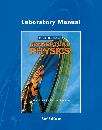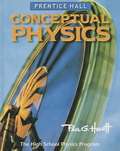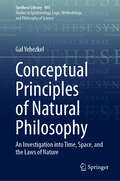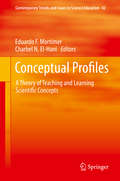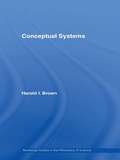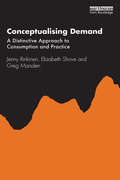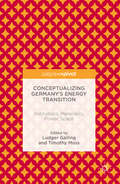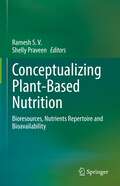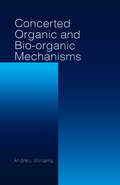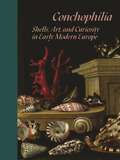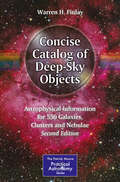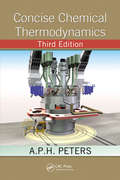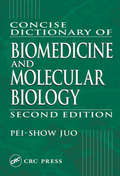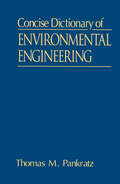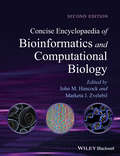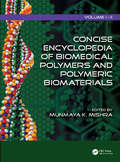- Table View
- List View
Conceptual Physics, 1999/2002
by Paul G. HewittThe author treats physics conceptually in this book, which means concepts are presented in familiar English, with equations as "guides to thinking." Comprehension of concepts before calculation is the key to understanding. Enjoy your physics!
Conceptual Physics: Laboratory Manual
by Paul RobinsonThis lab manual contains 61 activities and 38 experiments. Most activities are designed to provide you with hands-on experience that relates to a specific concept. Experiments are usually designed to give you practice using a particular piece of apparatus.
Conceptual Physics: The High School Physics Program
by Paul G. HewittThis seventh edition of the popular and exceptionally well written physics concept text with minimal mathematics contains new material sprinkled throughout, such as a treatment of measurements of the earth, moon, and sun by the early Greeks, capacitors, and more on rainbows. Individual sections have been clarified and updated. Problem sets are now at the end of most chapters. Most problems involve simple calculations that require minimal algebra skills. The text is profusely illustrated in full color with many helpful diagrams and down-to-earth examples. Annotation c. by Book News, Inc., Portland, Or.
Conceptual Physics: The High School Physics Program
by Paul G. HewittThis book guides the reader to see physics as the rules of the physical world, and to teach how the equations of physics reveal the connections in nature, focusing on the physics concepts themselves, their similarities, and their differences. This book contains analogies and clear explanations, more qualitative questions than algebraic problems to discover physics as fascinating, to provide a solid science foundation, and to see that knowledge of physics is important to overall education.
Conceptual Physics: The High School Physics Program
by Paul G. HewittThis seventh edition of the popular and exceptionally well written physics concept text with minimal mathematics contains new material sprinkled throughout, such as a treatment of measurements of the earth, moon, and sun by the early Greeks, capacitors, and more on rainbows. Individual sections have been clarified and updated. Problem sets are now at the end of most chapters. Most problems involve simple calculations that require minimal algebra skills. The text is profusely illustrated in full color with many helpful diagrams and down-to-earth examples. Annotation C. by Book News, Inc., Portland, Or.
Conceptual Physics: The High School Physics Program (3rd edition)
by Paul G. HewittPhysics textbook for high school students.
Conceptual Physics: The High School Physics Program with Expanded Technology (3rd edition)
by Paul G. HewittPhysics textbook for high school students
Conceptual Principles of Natural Philosophy: An Investigation into Time, Space, and the Laws of Nature (Synthese Library #495)
by Gal YehezkelThis book provides a general framework for understanding nature to revive the philosophical study of nature as a complementary research project to the empirical exploration of nature. It demonstrates that the a priori research of nature is a viable science, by articulating its principles and demonstrating their effectiveness in explaining the most fundamental features of nature – time, space, and its laws. The original contribution of this book is twofold. Firstly, it introduces a unique method for undertaking conceptual analysis. The effectiveness of these tools is demonstrated in exploring the most general and fundamental features of nature. Secondly, it introduces a novel conception of nature – "internal relationalism" – that offers an insight into the structure of nature and its most fundamental features. Thus, it offers answers to some of the most fundamental questions that have plagued philosophers and scientists for millennia, concluding with the question “Why is there something rather than nothing?” This book is of interest to metaphysics, philosophers of science who focus on the foundations of physics, and philosophically-minded physicists, especially those whose research interests include the nature of time and space.
Conceptual Profiles: A Theory of Teaching and Learning Scientific Concepts (Contemporary Trends and Issues in Science Education #42)
by Eduardo F. Mortimer Charbel N. El-HaniThe language of science has many words and phrases whose meaning either changes in differing contexts or alters to reflect developments in a given discipline. This book presents the authors' theories on using 'conceptual profiles' to make the teaching of context-dependent meanings more effective. Developed over two decades, their theory begins with a recognition of the coexistence in the students' discourse of those alternative meanings, even in the case of scientific concepts such as molecule, where the dissonance between the classical and modern views of the same phenomenon is an accepted norm. What began as an alternative model of conceptual change has evolved to incorporate a sociocultural approach, by drawing on ideas such as situated cognition and Vygotsky's influential concept of culturally located learning. Also informed by pragmatist philosophy, the approach has grown into a well-rounded theory of teaching and learning scientific concepts. The authors have taken the opportunity in this book to develop their ideas further, anticipate and respond to criticisms--that of relativism, for example--and explain how their theory can be applied to analyze the teaching of core concepts in science such as heat and temperature, life and biological adaptation. They also report on the implementation of a research program that correlates the responsiveness of their methodology to all the main developments in the field of science education. This additional material will inform academic discussion, review, and further enhancement of their theory and research model.
Conceptual Systems (Routledge Studies in the Philosophy of Science)
by Harold I. BrownNew concepts are constantly being introduced into our thinking. Conceptual Systems explores how these new concepts are entered into our systems along with sufficient continuity with older ideas to ensure understanding. The encyclopedic breadth of this text highlights the many different aspects and disciplines that together present an insightful view into the various theories of concepts. Harold Brown, a reputable author in the philosophy of science examines several historically influential theories of concepts as well as presenting a clear view on the general theory of conceptual change. Case studies discuss examples of conceptual change in the history of physics including the move in seventeenth century physics from Galileo to Descates to Newton; and the conceptual framework of the 'standard model' in the late twentieth century high-energy physics. The key central themes in the philosophy of science that are explored in detail in this enormous book make it an essential read for academics in this field.
Conceptual Theories in Structural Dynamics (Advanced Structured Materials #135)
by Farzad Hejazi Tan Kar ChunThis book discusses the conceptual theory of structural dynamics, using simplified methods and clear, concise explanations. It illustrates all the hypotheses in a simple and effective way and describes in detail the derivation of all related formulations. Further, comprehensive step-by-step explanations combined with conceptual derivations, drawings and figures allow readers to grasp all the analytical formulations related to the dynamics of structures. Covering free and forced vibrations of single- and multi-degree of freedom systems represented as structure, subjected to dynamic load, the book also explores the most common types of dynamic loads applicable to structures, such as harmonic loads, impact loads and earthquakes, presenting relevant details, derivations and effective problems to explain the concept for various conditions. In addition, each chapter provides examples at different levels to help students, researchers and engineers gain a better understanding of the topics better, and includes numerous real-world problems to familiarize readers with the challenges related to structural engineering.
Conceptualising Demand: A Distinctive Approach to Consumption and Practice
by Elizabeth Shove Greg Marsden Jenny RinkinenThis book addresses fundamental questions about the very idea of demand: how is it constituted, how does it change and how might it be steered? Conceptualising Demand focuses on five core propositions: that demand is derived from social practices; that it is made and not simply met; that it is materially embedded and temporally unfolding; and that it is modulated through many forms of policy and governance. In working through these claims, the book weaves concepts from the sociology of consumption, science and technology studies, policy analyses and social theories of practice together with empirical cases and new research into such topics as the rise of refrigerated foods, the emergence of online shopping and the transformation of energy demanding services. This innovative book takes a fresh look at the very idea of demand, a concept that is often taken for granted, but that is vital for scholars and students of energy, mobility, climate change and consumption, and anyone interested in the subject.
Conceptualizing Environmental Citizenship for 21st Century Education (Environmental Discourses in Science Education #4)
by Pedro Reis Andreas Ch. Hadjichambis Demetra Paraskeva-Hadjichambi Jan Činčera Jelle Boeve-de Pauw Niklas Gericke Marie-Christine KnippelsThis Open Access book is about the development of a common understanding of environmental citizenship. It conceptualizes and frames environmental citizenship taking an educational perspective. Organized in four complementary parts, the book first explains the political, economic and societal dimensions of the concept. Next, it examines environmental citizenship as a psychological concept with a specific focus on knowledge, values, beliefs and attitudes. It then explores environmental citizenship within the context of environmental education and education for sustainability. It elaborates responsible environmental behaviour, youth activism and education for sustainability through the lens of environmental citizenship. Finally, it discusses the concept within the context of different educational levels, such as primary and secondary education in formal and non-formal settings. Environmental citizenship is a key factor in sustainability, green and cycle economy, and low-carbon society, and an important aspect in addressing global environmental problems. It has been an influential concept in many different arenas such as economy, policy, philosophy, and organizational marketing. In the field of education, the concept could be better exploited and established, however. Education and, especially, environmental discourses in science education have a great deal to contribute to the adoption and promotion of environmental citizenship.
Conceptualizing Germany's Energy Transition: Institutions, Materiality, Power, Space
by Ludger Gailing Timothy MossThis is the first book to explore ways of conceptualizing Germany's ongoing energy transition. Although widely acclaimed in policy and research circles worldwide, the Energiewende is poorly understood in terms of social science scholarship. There is an urgent need to delve beyond descriptive accounts of policy implementation and contestation in order to unpack the deeper issues at play in what has been termed a 'grand societal transformation. ' The authors approach this in three ways: First, they select and characterize conceptual approaches suited to interpreting the reordering of institutional arrangements, socio-material configurations, power relations and spatial structures of energy systems in Germany and beyond. Second, they assess the value of these concepts in describing and explaining energy transitions, pinpointing their relative strengths and weaknesses and exploring areas of complementarity and incompatibility. Third, they illustrate how these concepts can be applied - individually and in combination - to enrich empirical research of Germany's energy transition.
Conceptualizing Plant-Based Nutrition: Bioresources, Nutrients Repertoire and Bioavailability
by Shelly Praveen Ramesh S. V.This book deliberates on the various aspects of plant-based nutrition. Plant-based nutrition has numerous potential health benefits as it is low on calories nevertheless high on nutrient density and satiety, and also nutrient supplementation makes them wholesome diets.Starting with the importance of biodiversity contributing to the nutrition, the book discusses the development or utilization of nutrient-dense crops/foods with their bioavailability properties and health effects. Further, it deals with the enrichment of micronutrients through bio-fortification, fortification, the role of food matrix, and nutrient bioavailability, including the role of plant-based milk alternatives. The linkage between food and health is also being discussed in the context of anti-nutritional factors, metabolic fate of the food, and genomics. Finally, the implications of next-gen biotech crops and food safety issues imperative to define the concept of safe nutrition are discussed.With contributions from plant nutrition experts, this book serves as a one-stop reference for plant scientists, food technologists, and nutritionists looking to understand the concept of plant-based nutrition and its linkage with human health.
Concert Halls by Nagata Acoustics: Thirty Years of Acoustical Design for Music Venues and Vineyard-Style Auditoria
by Yasuhisa Toyota Motoo Komoda Daniel Beckmann Marc Quiquerez Erik BergalThis visually stunning and data rich text catalogs the design of 32 concert halls by world-renowned acoustician Yasuhisa Toyota and his team at Nagata Acoustics, the firm behind the celebrated Walt Disney Concert Hall, the Hamburg Elbphilharmonie, and numerous others. Alongside architectural drawings and photographs, commentary on the design process and challenges of each hall provides insight for the dedicated listener to appreciate a wide range of internationally beloved concert venues. Summarized acoustical and architectural data for each of the halls will provide valuable reference information to architects and acousticians alike. Following the project anthology is an overview of the history, development, and acoustical features of vineyard- and surround-style concert halls. A broader discussion of design philosophy reveals the methods by which Toyota has guided architects to create world renowned halls. These technical and general discussions give architects the foundation to design for the performing arts, and provide audiences a new insight and perspective to consider the next time they attend a concert.
Concerted Organic and Bio-Organic Mechanisms (New Directions In Organic And Biological Chemistry Ser. #12)
by Andrew WilliamsThe concept of concerted mechanisms was formulated nearly 90 years ago and virtually all general organic chemistry texts mention it. Until now, however, no monograph has addressed the concept explicitly. Over the last two decades, substantial advancements made in the development of precise methods for elucidating concerted mechanisms have heightened the need for a comprehensive text on the subject.Concerted Organic and Bio-organic Mechanisms gathers the salient materials related to this emerging field into a single text. It sets forth the precise definition of concertedness-along with working sub-definitions-and describes rigorous experimental tools chemists can use to diagnose the existence or absence of concerted mechanisms.Advances in our understanding of concerted mechanisms lead to further questions. Concerted Organic and Bio-organic Mechanisms provides the background and the tools researchers need to consider these important questions and further advance the frontiers of reactions, synthesis, and catalysis.
Conchophilia: Shells, Art, and Curiosity in Early Modern Europe
by Hanneke Grootenboer Claudia Swan Anne Goldgar Marisa Anne BassA captivating historical look at the cultural and artistic significance of shells in early modern EuropeAmong nature’s most artful creations, shells have long inspired the curiosity and passion of artisans, artists, collectors, and thinkers. Conchophilia delves into the intimate relationship between shells and people, offering an unprecedented account of the early modern era, when the influx of exotic shells to Europe fueled their study and representation as never before. From elaborate nautilus cups and shell-encrusted grottoes to delicate miniatures, this richly illustrated book reveals how the love of shells intersected not only with the rise of natural history and global trade but also with philosophical inquiry, issues of race and gender, and the ascent of art-historical connoisseurship.Shells circulated at the nexus of commerce and intellectual pursuit, suggesting new ways of thinking about relationships between Europe and the rest of the world. The authors focus on northern Europe, where the interest and trade in shells had its greatest impact on the visual arts. They consider how shells were perceived as exotic objects, the role of shells in courtly collections, their place in still-life tableaus, and the connections between their forms and those of the human body. They examine how artists gilded, carved, etched, and inked shells to evoke the permeable boundary between art and nature. These interactions with shells shaped the ways that early modern individuals perceived their relation to the natural world, and their endeavors in art and the acquisition of knowledge.Spanning painting and print to architecture and the decorative arts, Conchophilia uncovers the fascinating ways that shells were circulated, depicted, collected, and valued during a time of remarkable global change.
Concise Biochemistry
by Anatoly Bezkorovainy Max E. RafelsonThis work offers succinct, medically-oriented coverage of biochemistry, examining biologically important materials and presenting the properties of nucleic acids as well as nucleic acid metabolism. Each metabolic process is integrated in a review of overall energy metabolism, diabetes and starvation. A solutions manual is available to instructors o
Concise Catalog of Deep-Sky Objects: Astrophysical Information for 550 Galaxies, Clusters and Nebulae (The Patrick Moore Practical Astronomy Series)
by Warren H. FinlayThis book is for the amateur astronomer who wants to know about the astrophysical nature of deep sky objects. The information is presented in a concise format and is equally valuable when used as background reading or, alternatively, at the telescope eyepiece. The past decades have seen an unprecedented increase in professional astronomers' understanding of astronomical objects. However, generally this information is contained in journal publications that most amateur astronomers either do not have access to or would find difficult to read. In this book, basic data on each object (e. g. , magnitude, location, distance, age if known) is presented in a way that allows the reader to quickly access the information. This is followed by some remarks that capture the most fascinating astrophysical facts. Although there are thousands of deep sky objects observed by astronomers, only a small number of these are commonly observed by a wide audience. Thus, coverage here is limited to approximately 500 of the most commonly observed objects in the Northern Hemisphere and - an enhancement for the Second Edition - approximately 50 of those in the Southern Hemisphere. These are visible from the southern limits of the United States as well as from the southern continents. Another new feature of the Second Edition is the addition of amateur photographic images of all the Messier objects.
Concise Chemical Thermodynamics
by A.P.H. PetersThe first two editions of Concise Chemical Thermodynamics proved to be a very popular introduction to a subject many undergraduate students perceive to be difficult due to the underlying mathematics. With its concise explanations and clear examples, the text has for the past 40 years clarified for countless students one of the most complicated bran
Concise Dictionary of Biomedicine and Molecular Biology
by Pei-Show JuoRapid advances in science, medicine, and molecular biology have created a large amount of new information on biomedicine and molecular biology. Keeping up with the latest information can become a cumbersome task for professionals and students working in these fields. Updated to include new terminology and accurate characterizations of previously ex
Concise Dictionary of Environmental Engineering
by Thomas M. PankratzConcise Dictionary of Environmental Engineering contains thousands of definitions of terms used in the field of environmental engineering, including technical terms, abbreviations, and product/process trademarks and brand names. It helps you make sense out of technical reports and papers, and makes finding the right word for your own reports and papers easy!
Concise Encyclopaedia of Bioinformatics and Computational Biology
by Marketa J. Zvelebil John M. HancockConcise Encyclopaedia of Bioinformatics and Computational Biology, 2nd Edition is a fully revised and updated version of this acclaimed resource. The book provides definitions and often explanations of over 1000 words, phrases and concepts relating to this fast-moving and exciting field, offering a convenient, one-stop summary of the core knowledge in the area. This second edition is an invaluable resource for students, researchers and academics.
Concise Encyclopedia of Biomedical Polymers and Polymeric Biomaterials
by Munmaya MishraThe Concise Encyclopedia of Biomedical Polymers and Polymeric Biomaterials presents new and selected content from the 11-volume Biomedical Polymers and Polymeric Biomaterials Encyclopedia. The carefully culled content includes groundbreaking work from the earlier published work as well as exclusive online material added since its publication in print. A diverse and global team of renowned scientists provide cutting edge information concerning polymers and polymeric biomaterials. Acknowledging the evolving nature of the field, the encyclopedia also features newly added content in areas such as tissue engineering, tissue repair and reconstruction, and biomimetic materials.

